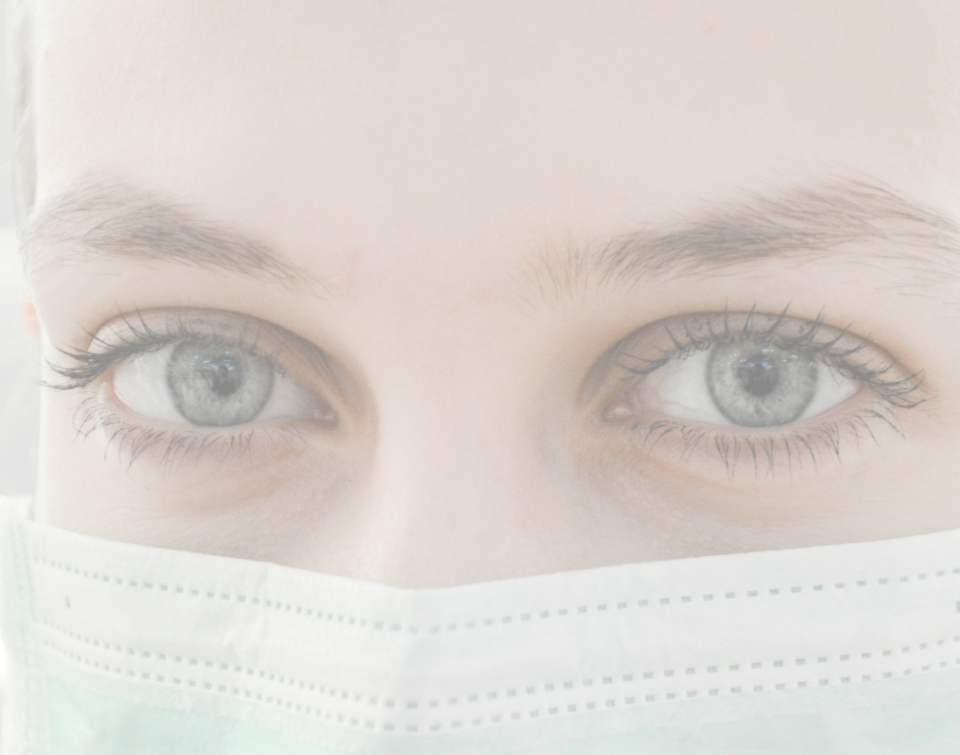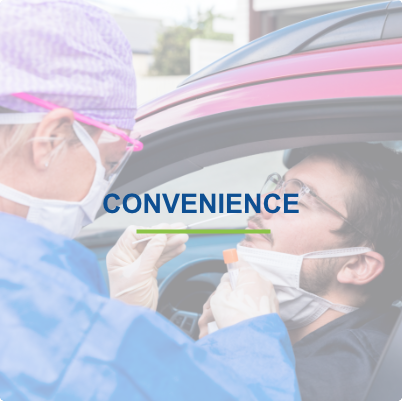
$130 up front1, recoverable through insurance2
Drive In and Be Swabbed
Test Results in 2 Days

Never leave your car. Results in 2 days after receiving your test.

The most accurate COVID-19 test available (RT-PCR)3

One price, paid in advance, that’s it, no surprises2

Results within 2 days of swab collection*
No, the RADT and RT-PCR test are very different from one another.
The RADT and nucleic acid test is FDA approved only for PERSONS WITH SYMPTOMS. This is because it might miss virus in someone with NO symptoms and, therefore, give an incorrect result.
The RT-PCR test is done in a CLIA-certified lab. This type of test is able to detect the presence of virus as early as one to three days after exposure before a person shows any illness. It is considered the gold standard test for those with and without symptoms.
Don’t trust a negative COVID rapid test if you feel fine. The FDA recommends all negative results in people WITHOUT symptoms be retested and confirmed by PCR testing.
If you’ve been recently exposed to a COVID-infected individual, it’s best to take an RT-PCR test confirmed in a lab since all NEGATIVE test results are truly negative.
Rapid tests are sensitive only when symptoms BEGIN. In fact, rapid tests are most sensitive five to seven days AFTER symptoms start. For this reason, the FDA recommends healthy individuals with negative results be retested and confirmed with an RT-PCR test.
There are a growing number of sites currently offering COVID-19 testing via TRUTH™. Use the map above to find an active location near you.
RT-PCR test results can be expected within 48 hours of receiving the specimen in our lab.
Rapid test results can take 15 minutes but are proven to be less accurate than RT-PCR tests, especially on healthy individuals.
A healthcare provider referral is not necessary to take your Truth™ test. But if you intend to submit the cost of the test to your health insurance plan for reimbursement, you will need a licensed healthcare provider to order the test for you.
The cost of our test is $130. The Truth™ approach is to make the cost for a laboratory test fully transparent, so you pay one time without any surprise bills or extra costs later.
Bubble testing is the wide testing of all healthy persons who are invited to a gathering where some in attendance could be at high risk for severe illness if they become infected with COVID. Some of these risk factors include obesity, chronic cardiovascular disease, diabetes, chronic respiratory disease, and immunocompromised and autoimmune conditions.
The best candidates for a COVID rapid antigen test are those individuals who have been sick with symptoms for five to seven days. If you are not showing symptoms, it’s best to get a nucleic acid amplification (RT-PCR) test.
Most people have mild COVID-19 symptoms and can recover at home without medical care. Contact your healthcare provider if your symptoms are getting worse or if you have questions about your health. Visit CDC.gov to find out what your test results mean.
If you have no COVID symptoms, go to mytruthtest.com and get your RT-PCR test to confirm your negative result.
The CDC offers step-by-step instructions for performing a deep nasal swab collection.
Antibody tests should not be used to diagnose a current COVID infection. It can take one to three weeks after infection for your body to make antibodies.
The COVID-19 antibody test is a blood test designed to detect antibodies to SARS-CoV-2, the virus that causes COVID-19 (this is not a test meant for detecting an active infection*). Antibodies are proteins that the body produces in response to infections. The antibodies can be produced even if a person has few or no symptoms during the infection.
It generally takes 1 to 3 weeks after an infection for antibodies from SARS-CoV-2 to become detectable in the blood. There is not enough evidence to know whether having antibodies to SARS-CoV-2 will prevent reinfection or if the virus is no longer present.
Currently, the FDA supports antibody testing with the following important points:
The COVID-19 antibody test is NOT meant for detecting an active infection. A RT-PCR swab test or saliva test should be used to test for active infection.
This test may be helpful if you:
This test can produce a false positive result IF you have been previously diagnosed with or exposed to other types of coronaviruses. It’s important to remember if you test too soon, your body may not have produced enough IgG antibodies to be detected by the test yet, which can lead to a false negative result.
This test may NOT be helpful if you:
The COVID-19 antibody test is a laboratory-based qualitative immunoglobulin (IgG) test. Results from the test can be positive (reactive), negative (non-reactive), or equivocal (borderline). There is no numerical value for this test.
The CDC and healthcare experts recommend you discuss your results and whether to return to work with your healthcare provider.
The most common to least common symptoms are listed below:
Overall mortality rate is 2% to 3%.
Acute Respiratory Distress Syndrome can develop when the body mounts what is called a "cytokine storm," where inflammatory markers cause the body to become extremely vulnerable to cardiopulmonary and respiratory collapse.
Diabetes, obesity, cancer, hypertension, chronic kidney disease, and smoking.
No, the symptoms of both COVID-19 and influenza overlap and the only way to differentiate is through lab testing.
It is recommended by the CDC that the patient obtain an RT-PCR test.
It can take several days to weeks for antibodies to develop after a first-time COVID infection.
Not necessarily. Studies are limited and have not yet shown that an antibody test confers complete immunity to COVID-19. However, reinfection rates are reported as extremely low by the CDC.
A decision-making framework can help us pace ourselves for this next phase in the pandemic marathon. There are a few core elements to consider as you plan for the holidays and gatherings ahead:
This may involve being creative in the winter months, layering up in warm gear, and setting up yards and outdoor spaces (such as parks) in new ways.
Ventilation and air circulation are your friends. Open windows, increase circulation, and keep room density as low as possible with fewer people in one space. See How Indoor Ventilation Systems Can Help Prevent or Permit the Spread of COVID-19 .
Wear masks whenever you are around people outside of your immediate pod (see #4) or household: at all times indoors, and outdoors when it’s not possible to be six feet or more away from others.
Consider setting up a small group of friends or family with similar mindsets and a commitment to restricting activities outside the pod. You’ll need to consider chains of transmission and avoid interactions with large numbers of people, or with individuals who may themselves be interacting with a large number of other people. Download a sample Pod Agreement. (Please note: This is a sample resource with public health principles. It is not legal or official health guidance and we acknowledge that these suggestions may not be feasible for all.)
Hand hygiene remains a critical way to help stem the spread.
Be prepared in case someone in your household or pod has exposure to a known COVID-19 case, exhibits symptoms, or is diagnosed. Know where you can be tested. Plan for how you would implement a 14-day quarantine if you are exposed. Plan for how you would isolate and care for an infected person in your home for at least 10 days (with an additional 14 days of quarantine for the caregiver who was in close contact after the infected person recovers).
We tend to think the two greatest risks of the pandemic are contracting or spreading COVID-19, but there are other risks as well. Consider whether anyone has a work or home situation that could be complicated by quarantine or isolation. Not all jobs allow for time off or working from home in the event of a need to quarantine, and some employers may even require testing before returning to work if there has been known exposure.
Travel brings its own particular considerations. Some states have implemented mandatory quarantines that could impose travel restrictions or fines for out-of-state travel or visitors. If you are exposed at an out-of-state gathering, you may have to unexpectedly extend your stay in that area for 14 days.
Traveling out of state may also mean quarantine requirements from your work or child’s school when you return home, particularly if you traveled to an area with high levels of community transmission. If you become ill shortly after you arrive at your destination, you may have to seek medical care in an area away from home.
Receive the nation’s most accurate COVID-19 testing available. Get results in 2 days on your mobile device (after your test day). 1. Medicare patients who are getting the COVID-19 test (Corona Virus) for medical necessity reasons must use their insurance. 2. You may be able to recover some or all of the price you paid by submitting the costs along with the documentation of medical necessity for the testing directly to your Health Insurance company. 3. Click here for more information on the RT-PCR diagnostic test.